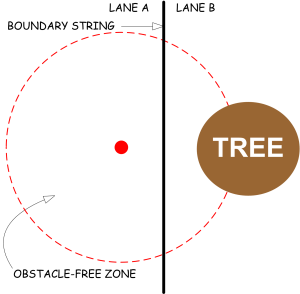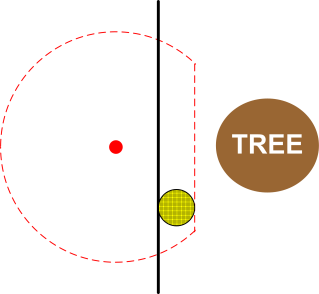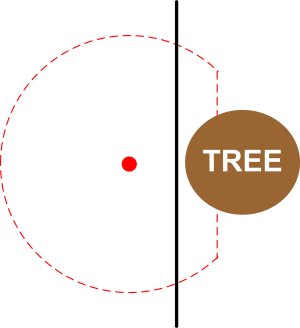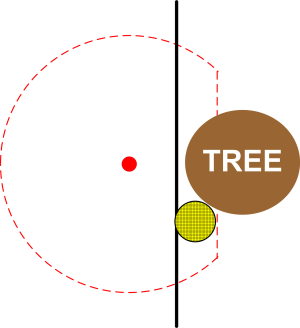Now that the FIPJP rules allow us to throw the jack right up to a side dead-ball line, I’m afraid we’ll never see the end of questions about whether a wooden surround is a pointing obstacle. All we can do is try to develop a clear answer to the question.
The FIPJP rules define two types of obstacles— throwing obstacles and pointing obstacles. The FIPJP rules specify that the throwing circle must be a certain minimum distance from any throwing obstacle, and the thrown (or placed) jack must be a certain minimum distance from any pointing obstacle.
Framing the rules this way focusses our attention on obstacles, and distances from obstacles.

I think that it would be more helpful to instead focus our attention on the objects involved— the jack and the throwing circle— and on the obstacle-free zones that those objects generate.

The rule about throwing obstacles is designed to create an obstacle-free area around the circle so that a player, standing in the center of that zone, can throw a boule without fear of hitting something that might injure his/her throwing hand. Basically, a throwing obstacle is an object that could injure a player if it is too close to him/her. That’s why the rule says, basically, that no such objects are permitted in the obstacle-free zone around the circle.
The rule about pointing obstacles is designed to create an obstacle-free area around the jack so that no object will physically prevent a boule from being pointed close to the jack. Basically, a pointing obstacle is an object that prevents a boule from being pointed close to the jack. That’s why the rule says that no such objects are permitted in the obstacle-free zone around the jack.
It’s as simple as that.
Using this point of view, let’s look at a question that came up recently on “Ask the Umpire”.
A boundary string separates lane A and lane B. There is a tree in lane B, close to the boundary string. Is it a pointing obstacle for lane A?
The answer is YES… in the following sense. If the jack is thrown out onto lane A, and if (when the jack comes to rest) the tree is inside the jack’s obstacle-free zone, then the tree is indeed a pointing obstacle. In that case, the thrown jack is not valid.

This answer assumes that boules from lane A can roll into lane B without dying, so the obstacle-free zone around the jack extends across the string and into lane B. But what if it is a time-limited game, and the boundary string is also a dead-ball line?
In that case, the jack’s obstacle-free zone extends only 8cm into lane B. If the tree is more than 8cm away from the dead-ball line, it is not within the jack’s obstacle-free zone. That means that the jack can be thrown right next to the dead-ball line and still be valid.

What is so magical about the 8cm distance? The maximum legal diameter of a boule is 8cm. As in the diagram (above), a boule can almost completely cross a dead-ball line and still be alive. But if it rolls any farther, it will die. That means that any object that is more than 8cm outside the dead-ball line can never be a pointing obstacle for a live boule. Any boule that reached it would be DOA: dead on arrival.
Conversely, a tree that is less than 8cm from the dead-ball line could be in the jack’s obstacle-free zone.

Since no two objects can occupy the same space at the same time, the tree really could be a pointing obstacle. In this diagram (below) we see that the tree really could prevent a live boule from entering part of the obstacle-free zone around the jack. That’s why in this case the thrown jack is invalid.

Is a wooden surround a pointing obstacle?
Our terrain is marked by dead-ball strings and enclosed by a wooden surround (boule-stop). Is the wooden surround a pointing obstacle?
The answer is exactly the same for the wooden surround as it was for the tree. A wooden surround that is less than 8cm from the dead-ball string can stop a live boule. So if the wooden surround is less than 8cm from the dead-ball string and less than 50cm from the thrown jack (i.e. inside the jack’s obstacle-free zone) the thrown jack is not valid. This is why a dead-ball string should always be installed more than 8cm from a wooden surround. The recommended minimum distance is 30cm.
Is a wooden surround a pointing obstacle when there is no dead-ball string?
Our terrain is enclosed by a wooden surround, but we have no dead-ball strings. Is the wooden surround considered to be a pointing obstacle?
YES. It is a pointing obstacle, and a thrown or placed jack must be at least 50cm from the wooden surround. Note, however, that because there are no dead-ball strings on your terrain, you are not playing by FIPJP rules— you are playing by your own local rules. You should adopt whatever local rule is agreeable to the two teams.
